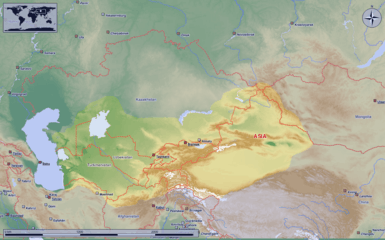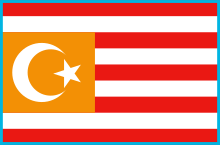Turkestan
Turkestan, also spelled Turkistan (Persian: ترکستان, romanized: Torkestân, lit. 'Land of the Turks'), is a historical region in Central Asia between Ural and Siberia to the north; the Gobi Desert to the east; Tibet, Kashmir, Afghanistan, and Iran to the south; and the Caspian Sea to the west.

Turkestan includes present-day Kazakhstan, Kyrgyzstan, Tajikistan, Turkmenistan, Uzbekistan, the Tarim Basin of China (also known as East Turkestan), and parts of northern Afghanistan (known as Afghan Turkestan).
Overview


Known as Turan to the Persians, western Turkestan has also been known historically as Sogdiana, "Ma wara'u'n-nahr" (by its Arab conquerors), and Transoxiana by Western travelers. The latter two names refer to its position beyond the River Oxus when approached from the south, emphasizing Turkestan's long-standing relationship with Iran, the Persian Empires, and the Umayyad and Abbasid Caliphates.
Turkestan is roughly within the regions of Central Asia lying between Siberia on the north; Tibet, Afghanistan, and Iran on the south; the Gobi Desert on the east; and the Caspian Sea on the west.[1] Oghuz Turks (also known as Turkmens), Uzbeks, Kazakhs, Khazars, Kyrgyz, Hazara and Uyghurs are some of the Turkic inhabitants of the region who, as history progressed, have spread further into Eurasia forming such Turkic nations as Turkey, and subnational regions like Tatarstan in Russia and Crimea in Ukraine. Tajiks and Russians form sizable non-Turkic minorities.
It is subdivided into Afghan Turkestan and Russian Turkestan in the West, and Xinjiang in the East.
Etymology and terminology
Of Persian origin (see -stan), the term "Turkestan" (ترکستان) has never referred to a single nation state.[2] Iranian geographers first used the word to describe the place of Turkic peoples.[3] "Turkestan" is used to describe any place where Turkic peoples lived.[2]
On their way southward during the conquest of Central Asia in the 19th century, the Russians under Nikolai Aleksandrovich Veryovkin took the city of Turkistan (in present-day Kazakhstan) in 1864. Mistaking its name for the entire region, they adopted the name of "Turkestan" (Russian: Туркестан) for their new territory.[3][4]
History
_(14580617778).jpg)
The history of Turkestan dates back to at least the third millennium BC. Many artifacts were produced in that period, with much trade being conducted. The region was a focal point for cultural diffusion, as the Silk Road traversed it. Turkestan covered the area of Central Asia and began acquiring a "Turkic" identity starting from the 6th century AD with the incipient Turkic migration.
Turkic sagas, such as the "Ergenekon" legend, and written sources, such as the Orkhon Inscriptions, state that Turkic peoples originated in the nearby Altai Mountains, and, through nomadic settlement, started their long journey westwards. Huns conquered the area after they conquered Kashgaria in the early 2nd century BC. With the dissolution of the Huns' Empire, Chinese rulers took over Eastern Turkestan. Arab forces captured it in the 8th century. The Persian Samanid dynasty subsequently conquered it and the area experienced economic success.[5] The entire territory was held at various times by Turkic forces, such as the Göktürks, until the conquest by Genghis Khan and the Mongols in 1220. Genghis Khan gave the territory to his son Chagatai and the area became the Chagatai Khanate.[5] Timur took over the western portion of Turkestan in 1369, and the area became part of the Timurid Empire.[5] The eastern portion of Turkestan was also called Mogulistan and continued to be ruled by descendants of Genghis Khan.
Chinese influence
In Chinese historiography, the Qara Khitai is most commonly called the "Western Liao" (西遼) and is considered to be a legitimate Chinese dynasty, as is the case for the Liao dynasty.[6] The history of the Qara Khitai was included in the History of Liao (one of the Twenty-Four Histories), which was compiled officially during the Yuan dynasty by Toqto'a et al.
After the Tang dynasty, non-Han Chinese empires gained prestige by connecting themselves with China; the Khitan Gurkans used the title of "Chinese emperor",[7][8] and the empire was also called the "Khan of Chīn".[9] The Qara Khitai used the "image of China" to legitimize their rule to the Central Asians. The Chinese emperor, together with the rulers of the Turks, Arabs, India and the Byzantine Romans, were known to Islamic writers as the world's "five great kings".[10] Qara Khitai kept the trappings of a Chinese state, such as Chinese coins, Chinese imperial titles, the Chinese writing system, tablets, seals, and used Chinese products like porcelein, mirrors, jade and other Chinese customs. The adherence to Liao Chinese traditions has been suggested as a reason why the Qara Khitai did not convert to Islam.[11] Despite the Chinese trappings, there were comparatively few Han Chinese among the population of the Qara Khitai.[12] These Han Chinese had lived in Kedun during the Liao dynasty,[13] and in 1124 migrated with the Khitans under Yelü Dashi along with other people of Kedun, such as the Bohai, Jurchen, and Mongol tribes, as well as other Khitans in addition to the Xiao consort clan.[14]
Qara Khitai's rule over the Muslim-majority Central Asia has the effect of reinforcing the view among some Muslim writers that Central Asia was linked to China even though the Tang dynasty had lost control of the region a few hundred years ago. Marwazī wrote that Transoxiana was a former part of China,[15] while Fakhr al-Dīn Mubārak Shāh defined China as part of "Turkestan", and the cities of Balāsāghūn and Kashghar were considered part of China.[16]
The association of Khitai with China meant that the most enduring trace of the Khitan's power is names that are derived from it, such as Cathay, the medieval Latin appellation for China. Names derived from Khitai are still in use, such as the Russian, Bulgarian, Uzbek and Mongolian names for China.[17] However, the use of "Khitai" to mean "China" or "Chinese" by Turkic speakers within China, such as the Uyghurs, is considered pejorative by the Chinese authorities, who have tried to ban it.[18]
See also
- East Turkestan
- Russian conquest of Central Asia
- Turkestan Krai (administrative unit within the Russian Empire)
References
- Encyclopadea Britannica. Turkistan retrieved-18 march,2010
- Gladys D. Clewell, Holland Thompson, "Lands and Peoples: The world in color," Volume 3, page 163. Excerpt: Never a single nation, the name Turkestan means simply the place of Turkish peoples.
- Central Asian review by Central Asian Research Centre (London, England), St. Antony's College (University of Oxford). "Soviet Affairs Study Group," Volume 16, page 3. Excerpt: The name Turkestan is of Persian origin and was apparently first used by Persian geographers to describe "the country of the Turks". The Russian Empire revived the word as a convenient name for the governorate-general established in 1867 (Russian: Туркестанское генерал-губернаторство); the terms Uzbekistan, Turkmenistan, etc., came into use only after 1924.
- Annette M. B. Meakin, "In Russian Turkestan: a garden of Asia and its people," page 44. Excerpt: On their way southward from Siberia in 1864, the Russians took it, and many writers affirm that mistaking its name for that of the entire region, they adopted the appellation of "Turkestan" for their new territory. Up to that time, they assure us Khanates of Bokhara, Khiva and Kokand were known by these names alone.
- "Turkistan", Encyclopædia Britannica 2007 Ultimate Reference Suite.
- Biran 2005, p. 93.
- Millward, James A. (2007). Eurasian Crossroads: A History of Xinjiang. Columbia University Press. pp. 42–. ISBN 978-0-231-13924-3.
- Biran, Michal (2001). "Like a Mighty Wall: The armies of the Qara Khitai" (PDF). Jerusalem Studies in Arabic and Islam. 25: 46. Archived from the original (PDF) on 2015-12-10.
- Biran 2005, p. 34.
- Biran 2005, p. 97.
- Biran 2005, p. 102, 196–201.
- Biran 2005, p. 96–.
- Biran 2005, p. 27–.
- Biran 2005, p. 146.
- Biran 2005, p. 98–99.
- Biran 2005, p. 99–101.
- Sinor, D. (1998), "Chapter 11 - The Kitan and the Kara Kitay" (PDF), in Asimov, M.S.; Bosworth, C.E. (eds.), History of Civilisations of Central Asia, 4 part I, UNESCO Publishing, ISBN 978-92-3-103467-1
- James A. Millward and Peter C. Perdue (2004). S.F.Starr (ed.). Xinjiang: China's Muslim Boarderland. M.E. Sharpe. p. 43. ISBN 9781317451372.CS1 maint: uses authors parameter (link)
Further reading
- V.V. Barthold "Turkestan Down to the Mongol Invasion" (London) 1968 (3rd Edition)
- René Grousset L'empire des steppes (Paris) 1965
- David Christian "A History Of Russia, Central Asia, and Mongolia" (Oxford) 1998 Vol.I
- Svat Soucek "A History of Inner Asia" (Cambridge) 2000
- Vasily Bartold Работы по Исторической Географии (Moscow) 2002
- English translation: V.V. Barthold Work on Historical Geography (Moscow) 2002
- Baymirza Hayit. "Sowjetrußische Orientpolitik am Beispiel Turkestan. "Köln-Berlin: Kiepenhauer & Witsch, 1956
- Hasan Bülent Paksoy Basmachi: Turkestan National Liberation Movement
- The Arts and Crafts of Turkestan (Arts & Crafts) by Johannes Kalter.
- The Desert Road to Turkestan (Kodansha Globe) by Owen Lattimore.
- Turkestan down to the Mongol Invasion. by W. BARTHOLD.
- Turkestan and the Fate of the Russian Empire by Daniel Brower.
- Tiger of Turkestan by Nonny Hogrogian.
- Turkestan Reunion (Kodansha Globe) by Eleanor Lattimore.
- Turkestan Solo: A Journey Through Central Asia, by Ella Maillart.
- Baymirza Hayit. "Documents: Soviet Russia's Anti-Islam-Policy in Turkestan. "Düsseldorf: Gerhard von Mende, 2 vols, 1958.
- Baymirza Hayit. "Turkestan im XX Jahrhundert. "Darmstadt: Leske, 1956
- Baymirza Hayit. "Turkestan Zwischen Russland Und China. "Amsterdam: Philo Press, 1971
- Baymirza Hayit. "Some thoughts on the problem of Turkestan" Institute of Turkestan Research, 1984
- Baymirza Hayit. "Islam and Turkestan Under Russian Rule." Istanbul:Can Matbaa, 1987.
- Baymirza Hayit. "Basmatschi: Nationaler Kampf Turkestans in den Jahren 1917 bis 1934." Cologne: Dreisam-Verlag, 1993.
- Mission to Turkestan: Being the memoirs of Count K.K. Pahlen, 1908–1909 by Konstantin Konstanovich Pahlen.
- Turkestan: The Heart of Asia by Curtis.
- Tribal Rugs from Afghanistan and Turkestan by Jack Frances.
- The Heart of Asia: A History of Russian Turkestan and the Central Asian Khanates from the Earliest Times by Edward Den Ross.
- Bealby, John Thomas; Kropotkin, Peter (1911). . In Chisholm, Hugh (ed.). Encyclopædia Britannica. 27 (11th ed.). Cambridge University Press. pp. 419–426.
- Turkestan avant-garde. Exhibition catalog. Design by Petr Maslov. M.: State Museum of Oriental Art, 2009.